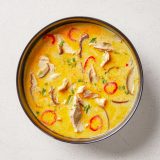The math of it all is staggering. In just a decade laboring under blue tarps on the side of Bang Phae Road an hour southwest of Bangkok, Uthai Buaban and his wife, Surang, have processed some 5.5 million fresh coconuts. No machines. Just knives, peelers, axes and an odd spear-like device.
Now multiply their output by the countless others doing the same work across Thailand. Staggering, indeed. And a vital effort that feeds the creamy coconut undercurrent in nearly every corner of the country’s cuisine.
Not surprisingly, nothing goes to waste. Surang starts the process, grabbing one of thousands of coconuts trucked to them daily from surrounding farms. Between her legs, an upright spear points menacingly upward. She pushes the green coconut onto it, splintering off the thick outer husk. They’ll sell that for biofuel.
Next, an axe chips away the fuzz from the center kernel before cutting a hole for draining the coconut water; that will be sold for making sugar. Uthai then uses a peeler to scrape away a papery brown coating, revealing a white core; it will be ground and pressed for coconut milk. Any scraps will be burned into charcoal.
In Thailand, it’s a short path from the Buabans’ roadside shop to something delicious. In my case, the path led to chef Piched Kaewhem’s outdoor kitchen in a Bangkok suburb.
Kaewhem offered to teach me tom kha gai, a simple but wonderfully flavorful chicken soup, the star of which was coconut milk. And he made it start-to-finish in minutes.
The coconut milk went first, 2 cups into a saucepan. Then lemon grass and galangal, a relative of ginger; they simmered until tender, treated not merely as seasoning. Thinly sliced chicken was next, then mushrooms, makrut lime leaves, lime juice, savory fish sauce, sugar, fresh chilies and Thai chili paste.
It was that easy. Punctuated with bright lime juice and hits of chili, the soup was grounded in the creamy richness of the coconut milk and the savory-meaty notes of the chicken.
Recreating it required subs for some hard-to-find ingredients, but the biggest challenge was the coconut milk. No matter which brand or variety we tried, the canned coconut milk we found in the U.S. never lived up to the fresh vibrancy of what I had in Thailand. Sometimes, this isn’t a big deal. And to be honest, you can make a good version of this soup from canned.
But if you really want to taste the soul of Thai cooking, it’s worth trying a little harder. And for that, we turned to a lesson we’d learned from another coconut milk-loving cuisine. In Colombia, pollo con leche de coco is a chicken soup made with fresh coconut milk. It was another case where we struggled to mirror the flavors we had on the ground.
Our solution was to make our own, a simple, speedy process that involves nothing more than soaking unsweetened shredded coconut in hot water, pulsing it in a blender, then straining out the resulting milk.
Admittedly, it lacks the romance of using milk freshly cleaved and pressed. But in terms of taste, it certainly captured the spirit of the moment.
Can the Canned Coconut Milk!
A lesson learned in Colombia was the secret to perfecting Thai coconut chicken soup
Photo: Joe Murphy; Styling: Wes Martin







